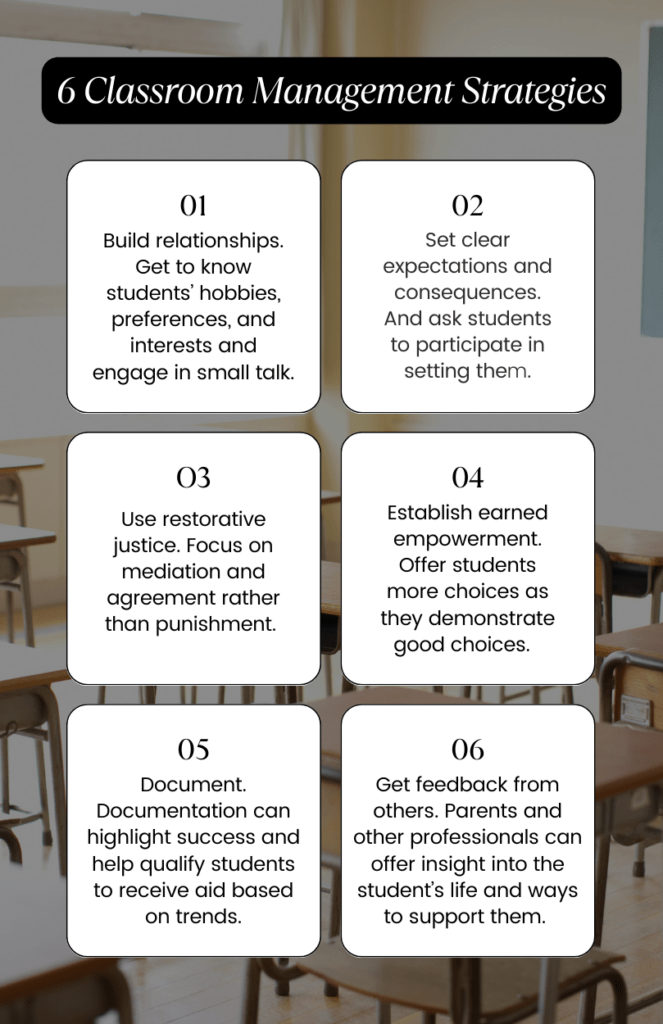Dealing with difficult students can be extremely frustrating when you have to alter class lessons or activities. And, if we aren’t careful, bad behavior can spread by empowering other students to misbehave and add to the off-task or inappropriate behavior. While there are many research-based classroom management strategies to consider using, let me highlight a few to incorporate, if you are not already doing so.
1. Build Relationships
One of the best classroom management strategies you can employ to minimize student disruptions is to build relationships with students. Get to know students’ hobbies, preferences, and interests. Include these in your content when possible. When you see students between classes, engage in small talk. Don’t try to be “one of the students,” but also, don’t ignore them when you are with peers. Building relationships with students can help create a positive classroom environment where students feel comfortable and respected. This can lead to fewer disruptions and a more productive learning experience for everyone. Additionally, by getting to know your students, you can tailor your teaching methods and content to better meet their needs and interests, which can increase engagement and motivation.
2. Set Clear Expectations and Consequences
It is easy to assume that the students understand the rules and consequences as well as you do. But, that may not be the case. Even if it isn’t an issue of “cheating,” students may have a vague idea of what a particular rule looks like or the nuances of the rule. A student may have another or previous teacher who did not enforce the rule/consequence, so the student believes that the rule/consequence isn’t really valuable or expected. Regardless of the grade level you teach, reviewing the rules and consequences is a good thing. Ask students to participate in setting the rules and consequences. In doing this, I found that the students could be harder on the group than I would have been in which case I had to temper the expectations to be less punitive and more realistic.
3. Use Restorative Justice
Restorative justice in the context of a classroom is an approach to discipline that focuses on mediation and agreement rather than punishment. It aims to get students to take responsibility for their actions, understand the harm they have caused, and make restitution to those affected. This approach can help create a positive classroom environment where students feel comfortable and respected, leading to fewer disruptions and a more productive learning experience for everyone. Restorative justice is not just a tool to use in a crisis, but can be used proactively to build and nurture meaningful relationships and a strong sense of community within the classroom. This setting doesn’t create a teacher versus student environment but instead uses positive peer pressure to help maintain order and promote a classroom environment that all students enjoy.
4. Establish Earned Empowerment
Some students respond well when they are allowed to make choices. Initially, you may be making assignments such as the seating arrangement, groupings, etc. As students demonstrate on-task behavior and respect for you and others, consider moving to an earned empowerment environment. This is one in which students have earned the ability to make choices because they have previously demonstrated good choices (doing homework, supporting peers, following classroom rules, etc.). When you move to this philosophy, be sure that you are fair and equitable as to how various levels of empowerment are earned.
5. Document, Document, Document
As educators, documenting student behavior and progress can be extremely time-consuming. However, a lack of documentation can actually undermine your success and your students’ ability to receive help based on trends or habits that they may be exhibiting in your classroom. Consider creating a Google Form that you can fill out as you walk around the room to document when needed. Include fields for student name, period, student behavior, and any notes. If you want the students to complete the form (highly advisable), then also include sections for them to identify what the expectation was and how they plan to correct the behavior or behave next time. Once students show you the completed form, you then approve them to click the Submit button for it to be added to the documentation spreadsheet. This helps you know that it was filled out correctly and holds them accountable to truthfully telling what happened.
6. Get Feedback from Others
Sometimes we have students who are difficult, and we have no clue how to help them. Our personalities might be completely different or we lack the experience to pull up the strategies that are needed to help those students. In these times, consider talking with the parent(s), a peer teacher, and/or the school counselor for input. Sometimes solutions can be very simple, yet we fail to see them for some reason. For example, a student may be struggling with a subject because they are not getting enough sleep at night or they are dealing with personal issues at home. By communicating with the parents and other professionals, we can gain insight into the student’s life and find ways to support them. Additionally, seeking advice from experienced teachers can provide us with new strategies and techniques to try in the classroom.

The challenge of handling difficult students in the classroom isn’t isolated to any one educator; it’s a universal experience that teachers confront at various stages of their careers. The classroom management strategies highlighted in this article, from building genuine relationships to consistently documenting student behaviors, offer a comprehensive approach to fostering a positive classroom environment. As educators, it’s our duty not just to impart knowledge but to shape the environment in which learning occurs. Each challenging moment is an opportunity for growth—for both the student and for you. Always stay curious, remain empathetic, and be proactive in fostering a classroom where every student feels valued and understood.

